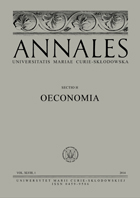Produktywność pracy w gospodarstwach rolnych w Polsce w zależności od ich wielkości ekonomicznej
Labour Productivity of Farms in Poland Depending on Their Economic Size
Author(s): Anna NowakSubject(s): Economy, Agriculture
Published by: Wydawnictwo Naukowe Uniwersytetu Marii Curie-Sklodowskiej
Keywords: labour productivity; farms; economic size of farm;produktywność pracy; gospodarstwa rolne; wielkość ekonomiczna gospodarstwa
Summary/Abstract: Theoretical background: The paper deals with issues related to labour productivity of farms. Productivity is connected with the optimum utilisation of the farm’s resources. The significance of studies on labour productivity can be attributed to the fact that it is one of the conditions for development and improvement of business competitiveness. Farms in Poland are highly differentiated; hence, economic analyses should be carried out for uniform groups.Purpose of the article: Assessment of labour productivity for farms of different economic size.Research methods: The study was carried out based on data from the European system for collecting accounting data on farms, i.e. FADN. The subjective scope of the study was Polish farms and the time span was 2010–2017. The analysis took into account six classes of economic size based on standard production value. Labour productivity was evaluated using partial productivity indicators.Main findings: The study showed a relationship between labour productivity and economic size of farms. In classes from 1 to 5 over all the analysed years, a growth in productivity was recorded resulting in successive upgrading of the farms to higher classes. The economically strongest farms had lower labour productivity than farms in class 5. This should be attributed to a higher share of less intensive crops in the structure of crops for this group of farms. It was demonstrated that the economically weakest farms, i.e. with standard production ranging from 2 to 8 thousand euro, achieved the lowest level of labour productivity. In 2017, it was only 23.7% of its average level for the whole population of farms covered by the study. This means that the economic power of farms determined effective utilisation of the labour factor. The studies also confirmed a relationship between the level of labour productivity and the level of technical resources. On the one hand, it points to a need for optimising the labour resources in agriculture, while on the other – to the necessity of implementing modernisation processes. The studies provide grounds for further research that should take into account a wider scope of determinants of improvement in the effective utilisation of the labour factor.
Journal: Annales Universitatis Mariae Curie-Skłodowska, Sectio H Oeconomia
- Issue Year: LIV/2020
- Issue No: 3
- Page Range: 79-89
- Page Count: 11
- Language: Polish

